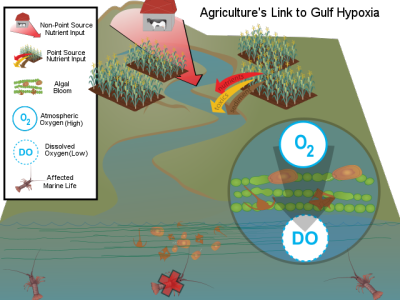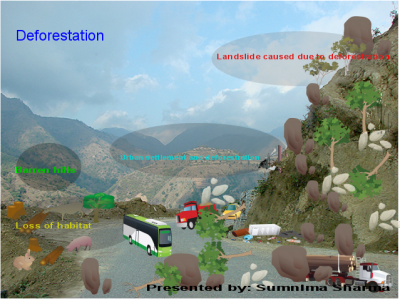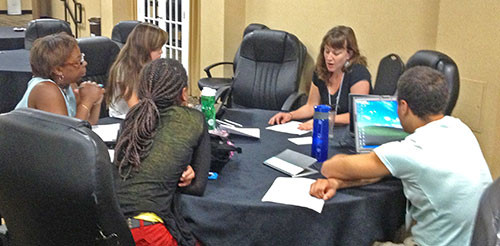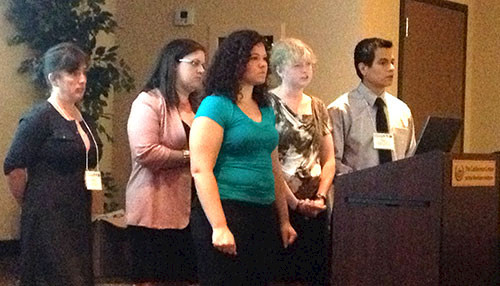Scaling Up: Future of Environmental Decisions workshop
Bill Dennison ·The Ecological Society of America (ESA) organized two simultaneous workshops for a) senior undergraduate and beginning graduate students in ecology and b) early career academic ecologists for a one-week training workshop during the week of 2-7 June 2013. The workshops were based at the Maritime Institute in Baltimore, Maryland and the National Science Foundation provided financial support. The Maritime Institute turned out to be an excellent venue, with great technical support and amazing buffet style food.
The University of Maryland Center for Environmental Science (UMCES) was heavily involved in the program, with Bill Dennison, Andrew Elmore, Steven Guinn, and Jane Thomas included in the planning and teaching of the undergraduate/graduate student workshop. In addition, Don Boesch was the after-dinner speaker on the first day. We also took a field trip to Chesapeake Biological Laboratory in Solomons, Maryland where Dave Secor provided welcoming remarks, and Mike Hulme, Bruce Cornwall and Dave Loewensteiner took students aboard the R/V Rachel Carson on a field trip to Chesapeake Bay and the Patuxent River. Jackie Takacs helped with logistics for the Jefferson Patterson Park and Museum field trip. Matt Fitzpatrick was involved in the early career workshop as well. In addition to UMCES staff, Allen Roberts from Tennessee State University helped with the spatial scaling issues, Alan Collins from West Virginia University and Carla Restrepo from the University of Puerto Rico-Rio Piedras helped with the social and economic issues, Brian Wee and Leah Wasser from the National Ecological Observatory Network (NEON) helped with the scaling and ecosystem services issues. The workshop organization was handled by the Ecological Society of America staff, Teresa Mourad, Andrea McMillen and Fred Abbott.
The students came from 15 states, plus the District of Columbia and Puerto Rico. They were diverse ethnically, geographically, and in terms of their major field of study. Several had recently graduated with their Bachelor's degree and one student even missed her graduation in order to attend the workshop. They traveled from near and far, from small private and large public universities, and were excited to be participating.
A pre-workshop webinar was used to get the students up to speed on the topics addressed during the workshop: Bill Dennison and Jane Thomas provided an overview of science communication and conceptual diagrams and introduced students to the IAN online conceptual diagram creator. As homework assignments, students produced conceptual diagrams about issues for the different parts of the country they reside in. During the workshop we had a 'poster session' to review the diagrams. A couple of our favorite diagrams are shown below.



Andrew Elmore and Steven Guinn provided an overview of Geographical Information Systems (GIS) and introduced students to QGIS software and oriented them to the data sets they had assembled regarding the Potomac watershed which the students were able to interrogate during the workshop.
The student group projects were diverse and multi-disciplinary, providing 'mash-ups' of ecological data with social and economic data. The oral presentations at the end of the week were uniformly well presented with seamless speaker transitions by well-dressed students. The presentations provided context, used active titles, and incorporated visual elements, often using conceptual diagrams created by the students. The questions that the student groups asked were interesting and the results often surprising. The comparative analyses using various layers of spatial data sets allowed the student groups to gain insights into a variety of topics. Several guests joined us for the student presentations; Doug Myers (Chesapeake Bay Foundation), Cindy Wei (National Socio-Environmental Synthesis Center), Chris Swan (University of Maryland Baltimore County), Katherine McCarter (Ecological Society of America).

The Northern Shoveler working group, which included Brenda Castro-Voltaggio, Yvan Delgado de la Flor, Jessica Flondro, Tracy Wendt, and Stephanie Wilson, presented a talk entitled "Constructing artifical wetlands in the Patuxent River Watershed". They produced an artificial wetlands targeting scheme (to make HAPPY fish and wildlife).
The Veined Rapa Whelk working group, which included Juan Botero, Tiona Johnson, Mark Rogers, Kelsey Stockert, and Becky Wood, presented a talk entitled "Do economic indicators correlate spatially with water quality?". They learned that wealth doesn't buy you ecohealth by comparing water quality in different counties (but would have been able to get better correlations if Juan had massaged the data).
The Fiddler Crab working group, which included Laura Bartock, John Brito, Aubrie James, Rugiyatu Kane, and Sumnima Sharma, presented a talk entitled "How are the trajectories of socioeconomic factors and water quality correlated in the Chesapeake watershed?". They learned that human population growth rates influence Bay health (and that short term data sets give 'better' results).
The Red-bellied Cooter working group, which included Rory Carroll, Jim Hagger, Laina Lockett, Dan Schall, and Cristina Martinez, presented a talk entitled "Suburbia influence on watersheds". They learned that suburban lawn fertilizer leaks nitrogen into streams (while they googled suburbia and dazzled us using Prezi).
The Lined Seahorse working group, which included Wanda Briscoe, Greg Patton, Mariana Quinones Rosado, and Joy Semien, presented a talk entitled "Trout as indicators of urbanization". They learned that brook trout live in low-nutrient, cool temperature streams (which eutrophies Wanda's brain).

The Scaling Up workshop was an immersive learning experience, with short, intense teaching. Students gained new insights and learned about how data can be scaled for different types of analyses. They appreciated the interdisciplinary science, made friends, learned QGIS, enjoyed the field trip aboard the boat and to the park, learned 'Why?', not just 'What?' and 'How?'. The one word summaries that students made at the end of the week included the following: grateful, appreciative, satisfied, eye-opening, real world, joy, inspiring, memorable, thrilled, diversity, bold, perspective, confident, thankful, expanded, in awe, fun, fascinating. My summary to the students was the following: "Inspired by you".
About the author
Bill Dennison

Dr. Bill Dennison is a Professor of Marine Science and Vice President for Science Application at the University of Maryland Center for Environmental Science.

